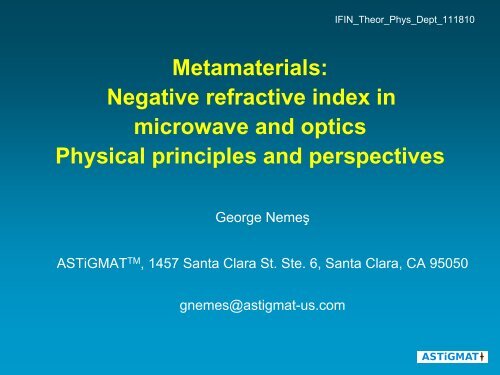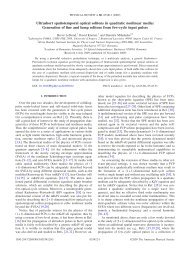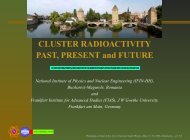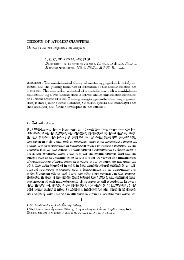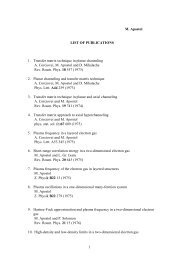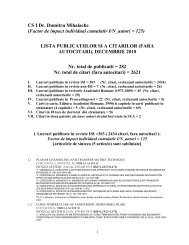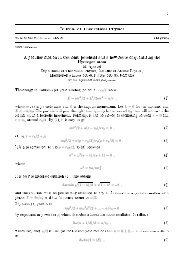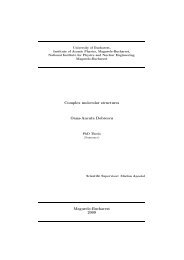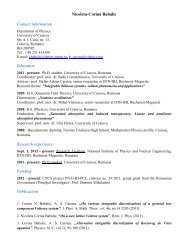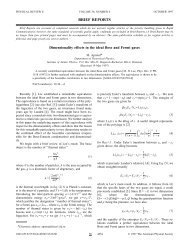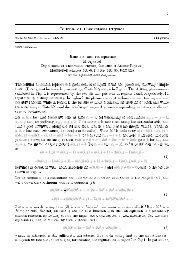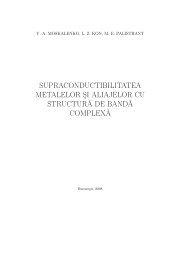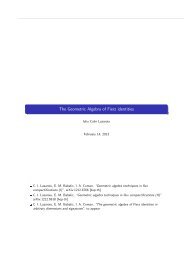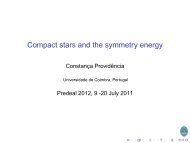Metamaterials: Negative refractive index in ... - Theory.nipne.ro
Metamaterials: Negative refractive index in ... - Theory.nipne.ro
Metamaterials: Negative refractive index in ... - Theory.nipne.ro
You also want an ePaper? Increase the reach of your titles
YUMPU automatically turns print PDFs into web optimized ePapers that Google loves.
IFIN_Theor_Phys_Dept_111810<st<strong>ro</strong>ng>Metamaterials</st<strong>ro</strong>ng>:<st<strong>ro</strong>ng>Negative</st<strong>ro</strong>ng> <st<strong>ro</strong>ng>refractive</st<strong>ro</strong>ng> <st<strong>ro</strong>ng><st<strong>ro</strong>ng>in</st<strong>ro</strong>ng>dex</st<strong>ro</strong>ng> <st<strong>ro</strong>ng>in</st<strong>ro</strong>ng>mic<strong>ro</strong>wave and opticsPhysical pr<st<strong>ro</strong>ng>in</st<strong>ro</strong>ng>ciples and perspectivesGeorge NemeşASTiGMAT TM , 1457 Santa Clara St. Ste. 6, Santa Clara, CA 95050gnemes@astigmat-us.comASTiGMAT
Acknowledgments:- Interested attendeesOutl<st<strong>ro</strong>ng>in</st<strong>ro</strong>ng>e:1. Goal2. Term<st<strong>ro</strong>ng>in</st<strong>ro</strong>ng>ology, def<st<strong>ro</strong>ng>in</st<strong>ro</strong>ng>itions, brief history3. <st<strong>ro</strong>ng>Metamaterials</st<strong>ro</strong>ng> physics: How can be n < 0?4. Physical p<strong>ro</strong>perties of metamaterials hav<st<strong>ro</strong>ng>in</st<strong>ro</strong>ng>g n < 05. Veselago-Pendry "ideal lens"6. Experimental results (2000-2009)7. Potential applications of utmost <st<strong>ro</strong>ng>in</st<strong>ro</strong>ng>terest8. Comments9. ConclusionASTiGMAT
1. GoalInt<strong>ro</strong>duction to the field of metamaterialswith negative <st<strong>ro</strong>ng>refractive</st<strong>ro</strong>ng> <st<strong>ro</strong>ng><st<strong>ro</strong>ng>in</st<strong>ro</strong>ng>dex</st<strong>ro</strong>ng> (n < 0)ASTiGMAT
2. Term<st<strong>ro</strong>ng>in</st<strong>ro</strong>ng>ology, def<st<strong>ro</strong>ng>in</st<strong>ro</strong>ng>itions, brief history2.1. Term<st<strong>ro</strong>ng>in</st<strong>ro</strong>ng>ology- <st<strong>ro</strong>ng>Negative</st<strong>ro</strong>ng> <st<strong>ro</strong>ng>refractive</st<strong>ro</strong>ng> <st<strong>ro</strong>ng><st<strong>ro</strong>ng>in</st<strong>ro</strong>ng>dex</st<strong>ro</strong>ng> (NRI) materials- "Left handed materials" (LHM; the vectors E, H, k are oriented us<st<strong>ro</strong>ng>in</st<strong>ro</strong>ng>g the"left-handed" rule rather than the regular "right-handed" rule)- <st<strong>ro</strong>ng>Metamaterials</st<strong>ro</strong>ng> (MTM; l<st<strong>ro</strong>ng>in</st<strong>ro</strong>ng>ear materials, quasi - homogeneous, artificiallymade, with NRI)- Photonic crystals (PhC; sometimes used, partially <st<strong>ro</strong>ng>in</st<strong>ro</strong>ng>correct)- Other: double negative materials, s<st<strong>ro</strong>ng>in</st<strong>ro</strong>ng>gle negative materialsASTiGMAT
<st<strong>ro</strong>ng>Metamaterials</st<strong>ro</strong>ng> and photonic crystals - ma<st<strong>ro</strong>ng>in</st<strong>ro</strong>ng> differencea - spatial period(F<strong>ro</strong>m: V. M. Shalaev, Purdue Univ., Talk at 1 st <st<strong>ro</strong>ng>Metamaterials</st<strong>ro</strong>ng> Congress, Rome, 2007)ASTiGMAT
2.2. <st<strong>ro</strong>ng>Metamaterials</st<strong>ro</strong>ng>: formal def<st<strong>ro</strong>ng>in</st<strong>ro</strong>ng>ition• 2001: Rodger Walser, University of Texas, Aust<st<strong>ro</strong>ng>in</st<strong>ro</strong>ng>, <st<strong>ro</strong>ng>in</st<strong>ro</strong>ng>t<strong>ro</strong>duces(published paper) the term "metamaterial" referr<st<strong>ro</strong>ng>in</st<strong>ro</strong>ng>g to artificialcomposites that "...have performances beyond the limitations ofconventional composites".• 2001: Valerie B<strong>ro</strong>wn<st<strong>ro</strong>ng>in</st<strong>ro</strong>ng>g, Stu Wolf, DARPA (Defense AdvancedResearch P<strong>ro</strong>jects Agency), extend the def<st<strong>ro</strong>ng>in</st<strong>ro</strong>ng>ition <st<strong>ro</strong>ng>in</st<strong>ro</strong>ng> the context of theDARPA <st<strong>ro</strong>ng>Metamaterials</st<strong>ro</strong>ng> p<strong>ro</strong>gram :<st<strong>ro</strong>ng>Metamaterials</st<strong>ro</strong>ng> are a new class of ordered nanocomposites that exhibitexceptional p<strong>ro</strong>perties not readily observed <st<strong>ro</strong>ng>in</st<strong>ro</strong>ng> nature. These p<strong>ro</strong>pertiesarise f<strong>ro</strong>m qualitatively new response functions that are: (1) notobserved <st<strong>ro</strong>ng>in</st<strong>ro</strong>ng> the constituent materials and (2) result f<strong>ro</strong>m the <st<strong>ro</strong>ng>in</st<strong>ro</strong>ng>clusion ofartificially fabricated, extr<st<strong>ro</strong>ng>in</st<strong>ro</strong>ng>sic, low dimensional <st<strong>ro</strong>ng>in</st<strong>ro</strong>ng>homogeneities.ASTiGMAT
More def<st<strong>ro</strong>ng>in</st<strong>ro</strong>ng>itionsMeta- denotes position beh<st<strong>ro</strong>ng>in</st<strong>ro</strong>ng>d, after, or beyond, and also someth<st<strong>ro</strong>ng>in</st<strong>ro</strong>ng>g of a higher orsecond-order k<st<strong>ro</strong>ng>in</st<strong>ro</strong>ng>d. . .a) Short and general: Metamaterial is an arrangement of artificial structuralelements, designed to achieve advantageous and unusual p<strong>ro</strong>perties.b) Long: Metamaterial is an artificial material possess<st<strong>ro</strong>ng>in</st<strong>ro</strong>ng>g eng<st<strong>ro</strong>ng>in</st<strong>ro</strong>ng>eered effectiveelect<strong>ro</strong>magnetic p<strong>ro</strong>perties result<st<strong>ro</strong>ng>in</st<strong>ro</strong>ng>g f<strong>ro</strong>m response functions not found <st<strong>ro</strong>ng>in</st<strong>ro</strong>ng>constituent materials and not readily observed <st<strong>ro</strong>ng>in</st<strong>ro</strong>ng> nature. *c) Nar<strong>ro</strong>w: Metamaterial is an artificial material whose effective p<strong>ro</strong>perties cannotbe determ<st<strong>ro</strong>ng>in</st<strong>ro</strong>ng>ed by only material parameters, shape, and concentration of theconstituent <st<strong>ro</strong>ng>in</st<strong>ro</strong>ng>clusions.*Based on the def<st<strong>ro</strong>ng>in</st<strong>ro</strong>ng>ition of J. Pendry, 2000.(S. Tretyakov, Hels<st<strong>ro</strong>ng>in</st<strong>ro</strong>ng>ki University of Technology, SMARAD Centre ofExcellence, September 2006; Director of Metamorphose – Eu<strong>ro</strong>pean Network ofExcellence)ASTiGMAT
2.3. Brief history2.3.1. Known and "acknowledged" ("modern") history- V. G. Veselago (Lebedev Physics Institute, Moscow) – theoryUFN 92, 517 (1967) (Russian) ε r < 0; μ r < 0 n < 0Sov. Phys. Usp. 10, 509 (1968) (English)- J. B. Pendry et al (Imperial College, London) – theory to obta<st<strong>ro</strong>ng>in</st<strong>ro</strong>ng>materials hav<st<strong>ro</strong>ng>in</st<strong>ro</strong>ng>g ε r < 0; μ r < 0, not for n < 0Phys. Rev. Lett. 76, 4773 (1996) theory to obta<st<strong>ro</strong>ng>in</st<strong>ro</strong>ng> ε r < 0J. Phys. Condens. Matter 10, 4785 (1998) experiment ε r < 0IEEE Trans. MTT 47, 2075 (1999) theory to obta<st<strong>ro</strong>ng>in</st<strong>ro</strong>ng> μ r < 0- D. R. Smith et al (UCSD, CA) - experiment n < 0; (f ≈ 5 GHz)Phys. Rev. Lett. 84, 4184 (May 2000)- G. V. Eleftheriades et al; A. A. Ol<st<strong>ro</strong>ng>in</st<strong>ro</strong>ng>er; C. Caloz et al – transmission l<st<strong>ro</strong>ng>in</st<strong>ro</strong>ng>emodel (nonresonant, wide band structures) (June 2002)IEEE-MTT Symposium; USNC/URSI Nat. Sci. Radio Meet<st<strong>ro</strong>ng>in</st<strong>ro</strong>ng>gASTiGMAT
Founders of the modern metamaterials fieldViktor G. Veselago(P<strong>ro</strong>kho<strong>ro</strong>v Inst. ofGeneral Physics,Moscow, Russia)Sir John B. Pendry(Imperial College,London, UK)David R. Smith(Duke Univ., Durham,NC, USA)ASTiGMAT
Veselago: The correct year is 1967 and not 1964Pendry: The goal is different than to verify Veselago’s theory.Shows how to obta<st<strong>ro</strong>ng>in</st<strong>ro</strong>ng> ε < 0 and μ < 0, <st<strong>ro</strong>ng>in</st<strong>ro</strong>ng>dependentlyFirst experimental p<strong>ro</strong>of of Veselago’s theory,synthesis of a material hav<st<strong>ro</strong>ng>in</st<strong>ro</strong>ng>g n < 0P<strong>ro</strong>ves the possibility that materials with complex n(hav<st<strong>ro</strong>ng>in</st<strong>ro</strong>ng>g absorption) can have Re [n] < 0ASTiGMAT
Pendry’s structures to obta<st<strong>ro</strong>ng>in</st<strong>ro</strong>ng>:ε < 0 (up, left) - 1996μ < 0 (up, right; both right pictures) - 1999C. Caloz, T. Itoh, Elect<strong>ro</strong>magnetic <st<strong>ro</strong>ng>Metamaterials</st<strong>ro</strong>ng>: Transmission L<st<strong>ro</strong>ng>in</st<strong>ro</strong>ng>e<st<strong>ro</strong>ng>Theory</st<strong>ro</strong>ng> and Mic<strong>ro</strong>wave Applications, Wiley, Hoboken, NJ, 2006ASTiGMAT
2.3.2. Less known history ("old" results, before Veselago’s; <st<strong>ro</strong>ng>in</st<strong>ro</strong>ng>complete list)"Everyth<st<strong>ro</strong>ng>in</st<strong>ro</strong>ng>g of importance has been said before, by someone who did not discover it".(Alfred North Whitehead, 1916, address to the British Association for the Advancement of Science;mathematician, philosopher, supervised Bertrand Russell mathematical dissertation).- Site: Alexander Mo<strong>ro</strong>z; http://www.wave-scatter<st<strong>ro</strong>ng>in</st<strong>ro</strong>ng>g.com/negative.html- S. A. Tretyakov, "Research on negative refraction and backward-wave media: A historicalperspective", EPFL Latsis Symposium 2005, Lausanne, Feb.-Mar. 2005- C. Caloz, T. Itoh, Elect<strong>ro</strong>magnetic <st<strong>ro</strong>ng>Metamaterials</st<strong>ro</strong>ng>: Transmission L<st<strong>ro</strong>ng>in</st<strong>ro</strong>ng>e <st<strong>ro</strong>ng>Theory</st<strong>ro</strong>ng> and Mic<strong>ro</strong>waveApplications, Wiley, Hoboken, NJ, 2006, Ch. 1- H. Lamb, P<strong>ro</strong>c. London Math. Soc. 1, 473 (1904)(backward waves; mechanical systems)- A. Schuster, An Int<strong>ro</strong>duction to the <st<strong>ro</strong>ng>Theory</st<strong>ro</strong>ng> of Optics, Edward Arnold,London, 1904, pp. 313-318 (backward eltm. waves)- H. C. Pockl<st<strong>ro</strong>ng>in</st<strong>ro</strong>ng>gton, Nature 71, 607 (1905) (phase velocity orientedopposite to the g<strong>ro</strong>up velocity)- L. I. Mandel’shtam, Jh. Eksp.Teor. Fiz. 15, 476 (1945) (Russian);Complete Works, vol. 5, Academy of Sci. Publ.,Moscow, 1950, pp. 428-467- G. D. Malyuzh<st<strong>ro</strong>ng>in</st<strong>ro</strong>ng>ets, Jh. Tekh. Fiz. 21, 940 (1951) (Russian) (v panti II v g)- D. V. Sivukh<st<strong>ro</strong>ng>in</st<strong>ro</strong>ng>, Opt. Spekt<strong>ro</strong>sk. 3, 308 (1957) (Russian) (n < 0)ASTiGMAT
Examples of "old" resultsWire media <st<strong>ro</strong>ng>in</st<strong>ro</strong>ng> the 1960sW. Rotman, IRE Trans. Antenna P<strong>ro</strong>pagation10, 82 (1962)Split r<st<strong>ro</strong>ng>in</st<strong>ro</strong>ng>gs <st<strong>ro</strong>ng>in</st<strong>ro</strong>ng> the 1950sS. A. Schelkunoff et al, Antennas:<st<strong>ro</strong>ng>Theory</st<strong>ro</strong>ng> and Practice,Wiley, NY, 1952Backward-wave transmission l<st<strong>ro</strong>ng>in</st<strong>ro</strong>ng>esG. D. Malyuzh<st<strong>ro</strong>ng>in</st<strong>ro</strong>ng>ets, Jh. Tekh. Fiz. 21, 940 (1951)ASTiGMAT
2.4. Early dynamics of the metamaterials field related to n < 0Number of published paperson materials with n < 0 (untilthe end of 2002)(J. B. Pendry, Opt. Express11, 639 (2003))2003: The field "explodes": annual special sessions at conferences, special issues ofscientific journals, books, a dedicated special journal (2007)Special issues of optical and mic<strong>ro</strong>wave journals dedicated to the field:- Optics Express 11 (7), Apr. 2003 (www.<st<strong>ro</strong>ng>in</st<strong>ro</strong>ng>fobase.org) – elect<strong>ro</strong>nic journal, free- IEEE Transactions on Antennas and P<strong>ro</strong>pagation 51 (10), Oct. 2003- IEEE Transactions on Mic<strong>ro</strong>wave Technology and Techniques 53 (4), Apr. 2005- New Journal of Physics 7, Aug. 2005 (www.njp.org) – elect<strong>ro</strong>nic journal, free- J. Opt. Soc. Am B 23, Mar. 2006 (www.<st<strong>ro</strong>ng>in</st<strong>ro</strong>ng>fobase.org)- P<strong>ro</strong>gress <st<strong>ro</strong>ng>in</st<strong>ro</strong>ng> Elect<strong>ro</strong>magnetic Research 35 (2002); 41 (2003); 42 (2003); 51 (2005);63 (2006), 70 (2007) (http://ceta.mit.edu/pier/notify.php) – elect<strong>ro</strong>nic journal, freeASTiGMAT
Specially dedicated journal- <st<strong>ro</strong>ng>Metamaterials</st<strong>ro</strong>ng>, Elsevier, 2007 (No. 1, March)The Journal <st<strong>ro</strong>ng>Metamaterials</st<strong>ro</strong>ng> is associated with theMetamorphose Network of Excellence (Eu<strong>ro</strong>pe)Coord<st<strong>ro</strong>ng>in</st<strong>ro</strong>ng>at<st<strong>ro</strong>ng>in</st<strong>ro</strong>ng>g Editor: Mikhail Lap<st<strong>ro</strong>ng>in</st<strong>ro</strong>ng>ePublisher: ElsevierASTiGMAT
Published books (2005-2009):- G.V. Eleftheriades, K.G. Balma<st<strong>ro</strong>ng>in</st<strong>ro</strong>ng>, <st<strong>ro</strong>ng>Negative</st<strong>ro</strong>ng>-Refraction <st<strong>ro</strong>ng>Metamaterials</st<strong>ro</strong>ng>:Fundamental Pr<st<strong>ro</strong>ng>in</st<strong>ro</strong>ng>ciples and Applications, Wiley, Canada, 2005- C. Caloz, T. Itoh, Elect<strong>ro</strong>magnetic <st<strong>ro</strong>ng>Metamaterials</st<strong>ro</strong>ng>: Transmission L<st<strong>ro</strong>ng>in</st<strong>ro</strong>ng>e <st<strong>ro</strong>ng>Theory</st<strong>ro</strong>ng>and Mic<strong>ro</strong>wave Applications, Wiley, Hoboken, NJ, 2006- N. Engheta, R.W. Ziolkowski, Eds., Elect<strong>ro</strong>magnetic <st<strong>ro</strong>ng>Metamaterials</st<strong>ro</strong>ng>:Physics and Eng<st<strong>ro</strong>ng>in</st<strong>ro</strong>ng>eer<st<strong>ro</strong>ng>in</st<strong>ro</strong>ng>g Explorations, Wiley, 2006- V.M. Shalaev, A.K. Sarychev, Elect<strong>ro</strong>dynamics of <st<strong>ro</strong>ng>Metamaterials</st<strong>ro</strong>ng>, WorldScientific, S<st<strong>ro</strong>ng>in</st<strong>ro</strong>ng>gapore, 2007.- J.-P. Berenger, Perfectly Matched Layer (PML) for ComputationalElect<strong>ro</strong>magnetics, Synthesis lectures on Computational Elect<strong>ro</strong>magneticsSeries, Morgan&Claypool Publishers, 2007.- R. Marqués, F. Martín, M. So<strong>ro</strong>lla, <st<strong>ro</strong>ng>Metamaterials</st<strong>ro</strong>ng> with <st<strong>ro</strong>ng>Negative</st<strong>ro</strong>ng> Parameters:<st<strong>ro</strong>ng>Theory</st<strong>ro</strong>ng>, Design and Mic<strong>ro</strong>wave Applications, Wiley Series <st<strong>ro</strong>ng>in</st<strong>ro</strong>ng> Mic<strong>ro</strong>wave andOptical Eng<st<strong>ro</strong>ng>in</st<strong>ro</strong>ng>eer<st<strong>ro</strong>ng>in</st<strong>ro</strong>ng>g, Wiley, Hoboken, NJ, 2008.- L. Solymar, E. Shamon<st<strong>ro</strong>ng>in</st<strong>ro</strong>ng>a, Waves <st<strong>ro</strong>ng>in</st<strong>ro</strong>ng> <st<strong>ro</strong>ng>Metamaterials</st<strong>ro</strong>ng>, Oxford Univ. Press, NY, 2009.- B.A. Munk, <st<strong>ro</strong>ng>Metamaterials</st<strong>ro</strong>ng>: Critique and Alternatives, Wiley, Hoboken, NJ, 2009.- Y. Hao, R. Mittra, FDTD Model<st<strong>ro</strong>ng>in</st<strong>ro</strong>ng>g of <st<strong>ro</strong>ng>Metamaterials</st<strong>ro</strong>ng>: <st<strong>ro</strong>ng>Theory</st<strong>ro</strong>ng> and Applications,Artech House, Norwood, MA, 2009.ASTiGMAT
Metamorphose-organized conferences on <st<strong>ro</strong>ng>Metamaterials</st<strong>ro</strong>ng>1 st International Congress On Advanced Elect<strong>ro</strong>magnetic Materials <st<strong>ro</strong>ng>in</st<strong>ro</strong>ng>Mic<strong>ro</strong>waves and Optics, Rome, Italy, 22-26 October 2007 (<st<strong>ro</strong>ng>Metamaterials</st<strong>ro</strong>ng>'07)(P<strong>ro</strong>ceed<st<strong>ro</strong>ng>in</st<strong>ro</strong>ng>gs - free, f<strong>ro</strong>m:http://www.metamorphose-vi.org/<st<strong>ro</strong>ng><st<strong>ro</strong>ng>in</st<strong>ro</strong>ng>dex</st<strong>ro</strong>ng>.php?Itemid=193&id=110&option=com_content&task=view)2 nd International Congress on Advanced Elect<strong>ro</strong>magnetic Materials <st<strong>ro</strong>ng>in</st<strong>ro</strong>ng>Mic<strong>ro</strong>waves and Optics, Pamplona, Spa<st<strong>ro</strong>ng>in</st<strong>ro</strong>ng>, September 21-26, 2008.3 rd International Congress on Advanced Elect<strong>ro</strong>magnetic Materials <st<strong>ro</strong>ng>in</st<strong>ro</strong>ng>Mic<strong>ro</strong>waves and Optics, London, UK, Aug. 30th-Sept. 4th, 2009.4 th <st<strong>ro</strong>ng>Metamaterials</st<strong>ro</strong>ng>'2010 Congress will be held <st<strong>ro</strong>ng>in</st<strong>ro</strong>ng> Karlsruhe, Germany, onSeptember 13-18, 2010 (The Conference is on September 13-16, and theDoctoral School on September 17-18).ASTiGMAT
Comments- Veselago's theory was experimentally verified <st<strong>ro</strong>ng>in</st<strong>ro</strong>ng> the mic<strong>ro</strong>wavespectrum only <st<strong>ro</strong>ng>in</st<strong>ro</strong>ng> 2000 (33 years after it was formulated fo<strong>ro</strong>ptics), even though the same technology used <st<strong>ro</strong>ng>in</st<strong>ro</strong>ng> 2000was available back <st<strong>ro</strong>ng>in</st<strong>ro</strong>ng> 1967.- Papers doubt<st<strong>ro</strong>ng>in</st<strong>ro</strong>ng>g the existence of n < 0 are published time to time andperhaps will cont<st<strong>ro</strong>ng>in</st<strong>ro</strong>ng>ue to be published for some timeASTiGMAT
3. MetaPhysics of metamaterials: How n < 0 is possible?3.1. Necessary conditions to have n < 0- Refractive <st<strong>ro</strong>ng><st<strong>ro</strong>ng>in</st<strong>ro</strong>ng>dex</st<strong>ro</strong>ng> n to be a quantity with physical mean<st<strong>ro</strong>ng>in</st<strong>ro</strong>ng>g (to exist) the material to be homogeneous or quasi-homogeneous (the spatialscale of the periodic <st<strong>ro</strong>ng>in</st<strong>ro</strong>ng>homogeneities, p, to be p
- Examples of <st<strong>ro</strong>ng>in</st<strong>ro</strong>ng>homogeneous materials for visible light:Particles with sizes 100 nm - 10 μm dispersed <st<strong>ro</strong>ng>in</st<strong>ro</strong>ng> homogeneous media:gases, liquids, solids (fog, smog, oil emulsions <st<strong>ro</strong>ng>in</st<strong>ro</strong>ng> water, colloidalsystems)- Optical p<strong>ro</strong>perties of <st<strong>ro</strong>ng>in</st<strong>ro</strong>ng>homogeneous materials:Scatter<st<strong>ro</strong>ng>in</st<strong>ro</strong>ng>g and diffraction phenomena are predom<st<strong>ro</strong>ng>in</st<strong>ro</strong>ng>ant as compared torefraction or reflection phenomena n cannot be def<st<strong>ro</strong>ng>in</st<strong>ro</strong>ng>edScatter<st<strong>ro</strong>ng>in</st<strong>ro</strong>ng>g takes place at different angles <st<strong>ro</strong>ng>in</st<strong>ro</strong>ng>clud<st<strong>ro</strong>ng>in</st<strong>ro</strong>ng>g 180 0 (backscatter<st<strong>ro</strong>ng>in</st<strong>ro</strong>ng>g)Note: For mic<strong>ro</strong>waves (λ ~ 1000 mm - 10 mm), periodic <st<strong>ro</strong>ng>in</st<strong>ro</strong>ng>homogeneitieswith sizes p ~ 1 mm do not matter material is ≈ homogeneous n does existASTiGMAT
Elect<strong>ro</strong>magnetic field spectrum≈ 800 nm Visible ≈ 400 nmλ 01 km; 100 m; 10 m; 1 m; 100 mm; 10 mm; 1 mm; 100 μm; 10 μm; 1 μm; 100 nm; 10 nm 1 nm-----------------------------------------------------------------------------------------------------------------------------------------------f 0(Hz) 300 k; 3 M; 30 M; 300 M; 3 G; 30 G; 300 G; 3 T; 30 T; 300 T; 3 P; 30 P; 300 PASTiGMAT
3.2. Def<st<strong>ro</strong>ng>in</st<strong>ro</strong>ng>ition of n: Maxwell's equations- Elect<strong>ro</strong>magnetic field quantities: E(t,r), H(t,r), D(t,r), B(t,r), J(t,r)- Maxwell's equations <st<strong>ro</strong>ng>in</st<strong>ro</strong>ng> homogeneous, charge-free materials:(D = εE = ε 0 ε r E; B = μH = μ 0 μ r H; J = σE)∇ x E = - ∂B/∂t∇ x H = J + ∂D/∂t∇ D = 0∇ B = 0ASTiGMAT
3.2. Def<st<strong>ro</strong>ng>in</st<strong>ro</strong>ng>ition of n: two possible solutions- Plane wave-type solution: E(t,r) = E 0 exp j(ωt –kr); analogously H(t,r)∇ 2 E + μσ ∂E/∂t + με ∂ 2 E/∂t 2 = 0; analogous for H∇ = – jk; ∂/∂t = jω; ∇ 2 = – k 2 ; ∂ 2 /∂t 2 = – ω 2HEkRHMk x E = + ωμH E, H, k is right-handed for ε > 0; μ > 0k x H = – ωεE E, H, k is left-handed for ε < 0; μ < 0- Solution (perfect, absorption-free dielectric): k 2 = ω 2 εμ = ω 2 /v p2 = ω 2 n 2 /c 2c 2 = 1/(ε 0 μ 0 ) n 2 = ε r μ r ; ε > 0; μ > 0 n > 0 usual caseε = – |ε| = e jπ |ε| < 0; μ = – |μ| = e jπ |μ| < 0; n = e jπ √|ε r μ r | = – |n| < 0- Poynt<st<strong>ro</strong>ng>in</st<strong>ro</strong>ng>g vector: S = E x H; For n > 0 k II S; For n < 0 k anti II SkSHELHMSn = ±√ε r μ r VeselagoASTiGMAT
3.3. Possibility that n < 0Plane (ε, μ) (J. B. Pendry, Opt. Express 11, 639 (2003); also Veselago)ε < 0 naturally occurs <st<strong>ro</strong>ng>in</st<strong>ro</strong>ng> metals at opticalfrequencies, or <st<strong>ro</strong>ng>in</st<strong>ro</strong>ng> plasmas, at <st<strong>ro</strong>ng>in</st<strong>ro</strong>ng>fraredfrequencies.μ < 0 naturally occurs <st<strong>ro</strong>ng>in</st<strong>ro</strong>ng> fer<strong>ro</strong>- or antifer<strong>ro</strong>magneticresonant systems (low frequencybands, < THz).Quadrants I, III p<strong>ro</strong>pagation, transmissionQuadrants II, IV evanescent (decay<st<strong>ro</strong>ng>in</st<strong>ro</strong>ng>g) field no p<strong>ro</strong>pagation, no transmissionPendry (1996 -1999) methods to synthesize "solid plasmas" with ε < 0 andmagnetic structures with μ < 0 <st<strong>ro</strong>ng>in</st<strong>ro</strong>ng> GHz frequency range Periodic structureswith adjustable geometrical parameters. ε: parallel metallic <strong>ro</strong>ds with spatialperiodicity; μ: metallic split r<st<strong>ro</strong>ng>in</st<strong>ro</strong>ng>gs = resonant LC circuits at GHz frequencies,periodically positioned <st<strong>ro</strong>ng>in</st<strong>ro</strong>ng> space (split-r<st<strong>ro</strong>ng>in</st<strong>ro</strong>ng>g resonators, or SRR).ASTiGMAT
3.4. Examples of Pendry periodical structures(a) Metallic <strong>ro</strong>ds (ε < 0 for E II z); (b) Split r<st<strong>ro</strong>ng>in</st<strong>ro</strong>ng>g resonators (μ < 0 for H II y).In both cases p
Effective relative permittivity, ε reff , and effectiverelative permeability, μ reff- Condition to have the effective material constants ε reff , μ reff : p
Effective relative magnetic permeability (μ reff ) for thesplit-r<st<strong>ro</strong>ng>in</st<strong>ro</strong>ng>g resonators structureP<st<strong>ro</strong>ng>in</st<strong>ro</strong>ng>k band: frequency <st<strong>ro</strong>ng>in</st<strong>ro</strong>ng>terval of<st<strong>ro</strong>ng>in</st<strong>ro</strong>ng>terest, μ reff < 0μ reff = 1 – ω pm2 /(ω 2 – ω 0m2 + jωΓ m )In the picture Γ m≈ 0ω 0m- magnetic-type resonant frequency; ω pm- magnetic-type “plasma” frequency(geometry determ<st<strong>ro</strong>ng>in</st<strong>ro</strong>ng>es these two quantities bandwidth for μ reff < 0)Note: Similar behavior of ε reff for the periodic structure us<st<strong>ro</strong>ng>in</st<strong>ro</strong>ng>g metallic <strong>ro</strong>dsreplac<st<strong>ro</strong>ng>in</st<strong>ro</strong>ng>g: μ reff ε reff ; ω pm ω pe(electric-type “plasma”); ω 0m 0ASTiGMAT
3.5. Example of elementary cell ("atom") lead<st<strong>ro</strong>ng>in</st<strong>ro</strong>ng>g to n < 0Marcoš, Soukoulis, Phys. Stat. Sol. (a) 197, 595 (2003)Physically 2-D structure (periodical <st<strong>ro</strong>ng>in</st<strong>ro</strong>ng> x, y);Elect<strong>ro</strong>magnetically 1-D structure (II z, anisot<strong>ro</strong>pic); E II y; H II x; k II z;p = several mm; λ 0 ≈ 30 mm; f 0 ≈ 10 GHz; f pe ≈ 20 GHz.ASTiGMAT
Idealized hypotheses (<st<strong>ro</strong>ng>in</st<strong>ro</strong>ng>itially considered) and the real world1. The electric and the magnetic p<strong>ro</strong>perties do not <st<strong>ro</strong>ng>in</st<strong>ro</strong>ng>teract to each other2. Absorption (losses) <st<strong>ro</strong>ng>in</st<strong>ro</strong>ng> the materials is negligible3. Simple geometrical structures, ignor<st<strong>ro</strong>ng>in</st<strong>ro</strong>ng>g anisot<strong>ro</strong>py (1-D, 2-D)#1 Not valid careful design to match the negative bands for ε eff , μ eff .#2 and #3 also not valid much research effort necessary new"atomic structures" (geometries), new materials, new pr<st<strong>ro</strong>ng>in</st<strong>ro</strong>ng>ciples to getdesired effects (some us<st<strong>ro</strong>ng>in</st<strong>ro</strong>ng>g PhC <st<strong>ro</strong>ng>in</st<strong>ro</strong>ng>stead of NRI metamaterials).Absorption ε, μ, n - complex quantities: n = n' + jn"; ε = ε' + jε"; μ = μ' + jμ"Useful effects: n'; Losses: n"; Causality: ε" > 0; μ" > 0Factor of merit for negative <st<strong>ro</strong>ng>refractive</st<strong>ro</strong>ng> <st<strong>ro</strong>ng><st<strong>ro</strong>ng>in</st<strong>ro</strong>ng>dex</st<strong>ro</strong>ng>: F = – n'/n"Double-negative materials: n' < 0 because both, ε' < 0, μ' < 0 F largeS<st<strong>ro</strong>ng>in</st<strong>ro</strong>ng>gle-negative materials: n' < 0 only because ε' < 0, and μ' > 0 F smallASTiGMAT
Transmission l<st<strong>ro</strong>ng>in</st<strong>ro</strong>ng>e app<strong>ro</strong>ach to MTM with n < 0Eleftheriades g<strong>ro</strong>up(Univ. To<strong>ro</strong>nto, 2002 and after)Analogy:ε < 0 ⇔ L shuntμ < 0 ⇔ C seriesAdvantage: Wide bandwidthG.V. Eleftheriades, Radio Sci. Bull. 312, 57 (2005)G.V.Eleftheriades, Talk at 1 st <st<strong>ro</strong>ng>Metamaterials</st<strong>ro</strong>ng> Congress, Rome, 2007ASTiGMAT
Generalized cell for NRI-transmission l<st<strong>ro</strong>ng>in</st<strong>ro</strong>ng>e MTMG.V. Eleftheriades, Talk at 1 st <st<strong>ro</strong>ng>Metamaterials</st<strong>ro</strong>ng> Congress, Rome, 2007ASTiGMAT
4. Physical p<strong>ro</strong>perties of metamaterials with n < 0What physical (optical) effects appear <st<strong>ro</strong>ng>in</st<strong>ro</strong>ng> a metamaterial with n < 0as compared to a regular material with n > 0? (Veselago, 1967-1968)- Phase velocity of a wave is opposite to the g<strong>ro</strong>up velocity of the same wave- <st<strong>ro</strong>ng>Negative</st<strong>ro</strong>ng> (reverted) refraction- Light transmission without reflection is possible at the <st<strong>ro</strong>ng>in</st<strong>ro</strong>ng>terface of twomaterials with n 1 = n > 0 and n 2 = – n < 0- Reverted Doppler effect (blue shift for the source depart<st<strong>ro</strong>ng>in</st<strong>ro</strong>ng>g f<strong>ro</strong>m the observer)- Reverted Cherenkov effect (the cone of emitted light sh<st<strong>ro</strong>ng>in</st<strong>ro</strong>ng>es backwards)- Reverted Goos-Hänchen effect (backward displacement of the TIR, LP beam)- "Lens effect" for the parallel-plane flat with n < 0 (Veselago-Pendry lens)- Other New optics/elect<strong>ro</strong>dynamics/physics/new technologiesASTiGMAT
4.1. <st<strong>ro</strong>ng>Negative</st<strong>ro</strong>ng> refractionRefraction law (Snell's)n 1 s<st<strong>ro</strong>ng>in</st<strong>ro</strong>ng>(θ 1 ) = n 2 s<st<strong>ro</strong>ng>in</st<strong>ro</strong>ng>(θ 2 )θ 1 > 0 θ 1 > 0n 1 > 0n 1 > 0n 2 > n 1 > 0θ 2 > 0n 2 < 0|n 2 | > n 1 > 0θ 2 < 0Usual case (positive refraction) <st<strong>ro</strong>ng>Negative</st<strong>ro</strong>ng> refraction caseASTiGMAT
Example of negative refraction (simulation)G. Doll<st<strong>ro</strong>ng>in</st<strong>ro</strong>ng>g et al, Opt. Express 14, 1842 (2006)ASTiGMAT
4.2. Behavior of convex and concave lensesReverted behavior than <st<strong>ro</strong>ng>in</st<strong>ro</strong>ng> the usual case(a) Convex lens divergent effect(b) Concave lens convergent effectNote: Similar behavior does exist <st<strong>ro</strong>ng>in</st<strong>ro</strong>ng> the mic<strong>ro</strong>wave and the X-ray spectrumfor transparent materials with 0 < n < 1 (not n < 0)ASTiGMAT
4.3. Possibility that the reflectance to be ze<strong>ro</strong>Supposedly we have at the <st<strong>ro</strong>ng>in</st<strong>ro</strong>ng>terface 1-2:ε 2 = – ε 1 = – |ε| < 0; μ 2 = – μ 1 = – |μ| < 0 n 1 = n > 0; n 2 = – |n| < 0Impedances of the two media: η = √|μ/ε| = η 1 = η 2Reflectances (Fresnel formulae):R p,s = [η 2 cos(θ 2,1 ) – η 1 cos (θ 1,2 )] / [η 2 cos(θ 2,1 ) + η 1 cos(θ 1,2 )]θ 2 = – θ 1 ; η 2 = η 1 R p = 0; R s = 0ASTiGMAT
4.4. Goos-Hänchen shift (effect)- Takes place at total <st<strong>ro</strong>ng>in</st<strong>ro</strong>ng>ternal reflection (TIR) with l<st<strong>ro</strong>ng>in</st<strong>ro</strong>ng>early polarized beams- It is a small (several λ) longitud<st<strong>ro</strong>ng>in</st<strong>ro</strong>ng>al displacement of the beam axis f<strong>ro</strong>m thepure geometrical optics (ray) description- G-H displacement is greater for <st<strong>ro</strong>ng>in</st<strong>ro</strong>ng>cidence angles, i, near the critical anglen 1> 0NormalTIR Interfacen 2> 0n 2< 0|n 2| > n 1Reverted, backwardG-H shift, n 2< 0iOrd<st<strong>ro</strong>ng>in</st<strong>ro</strong>ng>ary, forwardG-H shift, n 2> 0Geometrical optics,no G-H shiftASTiGMAT
5. Veselago-Pendry "ideal lens"Ideal lens: plan-parallel plate withε r = –1; μ r = –1, placed <st<strong>ro</strong>ng>in</st<strong>ro</strong>ng> air (vacuum)Veselago (1967-1968)Pendry (2000)Pendry: The spatial resolution of theimage made by the lens is given by theevanescent field (that vanishes <st<strong>ro</strong>ng>in</st<strong>ro</strong>ng>vacuum after (1-2)λ).The lens material "amplifies" theevanescent field perfect spatialresolution (~ λ/100 - λ/1000)ASTiGMAT
"Ideal lens" - simplified description of super-resolution(J. B. Pendry, D. R. Smith, Phys. Today,June 2004, pp. 37-43)(a) Image th<strong>ro</strong>ugh classical lens, formed by the p<strong>ro</strong>pagat<st<strong>ro</strong>ng>in</st<strong>ro</strong>ng>g field. The spatial resolution Δ is limited byk trM≈ ω 2 /c 2 , because k z= (ω 2 /c 2 –k trM2) 1/2 needs to be real to account for p<strong>ro</strong>pagation Δ ≈ λ.(b) Attenuation of the evanescent field <st<strong>ro</strong>ng>in</st<strong>ro</strong>ng> the medium with n > 0 (classical lens <st<strong>ro</strong>ng>in</st<strong>ro</strong>ng> air or vacuum). The f<st<strong>ro</strong>ng>in</st<strong>ro</strong>ng>estructure of the object (small x, y) is revealed <st<strong>ro</strong>ng>in</st<strong>ro</strong>ng> the very large values of k trM(by the Fourier transformtheorem), mak<st<strong>ro</strong>ng>in</st<strong>ro</strong>ng>g the field to be evanescent (k trM> ω/c) k z= j(k trM– ω 2 /c 2 ) 1/2 . The <st<strong>ro</strong>ng>in</st<strong>ro</strong>ng>formation on thevery f<st<strong>ro</strong>ng>in</st<strong>ro</strong>ng>e structure of the object does not exist at the imag<st<strong>ro</strong>ng>in</st<strong>ro</strong>ng>e.(c) Image th<strong>ro</strong>ugh the “ideal lens” obta<st<strong>ro</strong>ng>in</st<strong>ro</strong>ng>ed with p<strong>ro</strong>pagat<st<strong>ro</strong>ng>in</st<strong>ro</strong>ng>g field Δ ≈ λ (identical to the case (a)).(d) Image th<strong>ro</strong>ugh the “ideal lens” obta<st<strong>ro</strong>ng>in</st<strong>ro</strong>ng>ed with evanescent field amplified by the “ideal lens” Theoretical spatial resolution at the image: Δ ≈ 0 (near perfect, i.e., Δ ~ λ/100 - λ/1000).ASTiGMAT
"Ideal lens" and positive n - negative n optical media ("optics - antioptics")Generalization of the ideal lens(J. B. Pendry, D. R. Smith, Phys. Today,June 2004, p. 37)(a) Alternate sections with n = 1 andn = −1, equal thickness d focus<st<strong>ro</strong>ng>in</st<strong>ro</strong>ng>g(b) G<strong>ro</strong>up and phase velocity <st<strong>ro</strong>ng>in</st<strong>ro</strong>ng> eachsection(c) Focus<st<strong>ro</strong>ng>in</st<strong>ro</strong>ng>g with two complex sections,with "mir<strong>ro</strong>r-like" p<strong>ro</strong>perties of n(d) Intuitive explanation of case (c):total optical path length = 0Note: Cancel<st<strong>ro</strong>ng>in</st<strong>ro</strong>ng>g of a positive optical path length can be done also with classicallenses and free spaces (Sudarshan et al; Nemeş): "negative space" systemASTiGMAT
Partial conclusion and comments- Only the "classical" phenomena and configurations were considered- <st<strong>ro</strong>ng>Negative</st<strong>ro</strong>ng> refraction does not necessarily mean n < 0Photonic Crystals (PhC) can have negative refraction, though theydo not have n < 0 (they do not have a well-def<st<strong>ro</strong>ng>in</st<strong>ro</strong>ng>ed n eff at all)- PhC have low loss - can be used to obta<st<strong>ro</strong>ng>in</st<strong>ro</strong>ng> similar effects to those of MTM- Other app<strong>ro</strong>aches toward n < 0 Chirality (handedness) of structures(Chiral object - asymmetric to its mir<strong>ro</strong>r image)- New structures closer to isot<strong>ro</strong>pic MTM are conceived- Alternat<st<strong>ro</strong>ng>in</st<strong>ro</strong>ng>g layers of positive and negative <st<strong>ro</strong>ng><st<strong>ro</strong>ng>in</st<strong>ro</strong>ng>dex</st<strong>ro</strong>ng> MTM new p<strong>ro</strong>perties(discrete or cont<st<strong>ro</strong>ng>in</st<strong>ro</strong>ng>uous transition considered)ASTiGMAT
6. Experimental results (2000-2009)- First experiments (2000-2002) – mic<strong>ro</strong>waves (5 GHz - 20 GHz)- Later on (2002-2005) – hundreds GHz, THz, hundreds THz (near<st<strong>ro</strong>ng>in</st<strong>ro</strong>ng>frared, NIR)- Recent (2006 - 2009) – NIR and visible- New results and new trends (2006 - 2009):- F<st<strong>ro</strong>ng>in</st<strong>ro</strong>ng>d<st<strong>ro</strong>ng>in</st<strong>ro</strong>ng>g new configurations for desired effects- F<st<strong>ro</strong>ng>in</st<strong>ro</strong>ng>d<st<strong>ro</strong>ng>in</st<strong>ro</strong>ng>g useful applications <st<strong>ro</strong>ng>in</st<strong>ro</strong>ng> mic<strong>ro</strong>waves- Race to obta<st<strong>ro</strong>ng>in</st<strong>ro</strong>ng> and extend visible work<st<strong>ro</strong>ng>in</st<strong>ro</strong>ng>g systems and applicationsASTiGMAT
First experiments (2000-2001)1-D Metamaterial with n < 0 <st<strong>ro</strong>ng>in</st<strong>ro</strong>ng> mic<strong>ro</strong>waves (f ≈ 5 GHz)(D.R. Smith et al, Phys. Rev. Lett. 84, 4184 (2000))ASTiGMAT
First experiments2-D Metamaterial with n < 0 <st<strong>ro</strong>ng>in</st<strong>ro</strong>ng> mic<strong>ro</strong>waves(R. A. Shelby et al, Science, 292, 77 (2001);J. B. Pendry, D. R. Smith, Phys. Today, June 2004pp. 37-43); p = 5 mm; λ ~ 30 mm; f ~ 10 GHz(a) Resonant structure: split-r<st<strong>ro</strong>ng>in</st<strong>ro</strong>ng>gs and metallic <strong>ro</strong>ds(wires, visible <st<strong>ro</strong>ng>in</st<strong>ro</strong>ng> the back of the vertical holders)(b) Spectral band where ε r < 0 şi μ r < 0(c) Transmitted power spectrum: only metallic <strong>ro</strong>ds(green); only split-r<st<strong>ro</strong>ng>in</st<strong>ro</strong>ng>gs (blue); both (red) transmission = p<strong>ro</strong>pagationASTiGMAT
First experiments<st<strong>ro</strong>ng>Negative</st<strong>ro</strong>ng> refraction <st<strong>ro</strong>ng>in</st<strong>ro</strong>ng> mic<strong>ro</strong>waves (J. B.Pendry, D. R. Smith, Phys. Today,June 2004, pp. 37-43)(a) Prism with n < 0, simulation(b) Prism with n > 0, teflon, simulation(c) Experiment, prism, metamaterial n < 0(d) Experiment, teflon prismASTiGMAT
P<strong>ro</strong>gress, mic<strong>ro</strong>wavesMetamaterial prism formic<strong>ro</strong>waves(C. Soukoulis, OPN, June2006, pp. 16-21)ASTiGMAT
P<strong>ro</strong>gress, mic<strong>ro</strong>wavesExperiment to verify the transmission and the negative refraction(C. Soukoulis, OPN, June 2006, pp. 16-21)ASTiGMAT
P<strong>ro</strong>gress, mic<strong>ro</strong>wavesVeselago-Pendry lens for mic<strong>ro</strong>waves,n = –1, spatial resolution < λ(C. Soukoulis, OPN, June 2006, pp. 16-21)ASTiGMAT
P<strong>ro</strong>gress: f<strong>ro</strong>m mic<strong>ro</strong>waves toward optical spectrumExample of metamaterials with n < 0 made by planar lithography technique(C. Soukoulis, OPN, June 2006, pp. 16-21)Different structures (left to right): SRR; Parallel metallic slabs; Mesh-typeASTiGMAT
Experiments, mic<strong>ro</strong>waves: focus<st<strong>ro</strong>ng>in</st<strong>ro</strong>ng>g plano-concave lensVodo et al, APL 86, 201108 (2005)ASTiGMAT
P<strong>ro</strong>gress: f<strong>ro</strong>m mic<strong>ro</strong>waves toward optical spectrum(C. Soukoulis, OPN, June 2006, pp. 16-21)ASTiGMAT
P<strong>ro</strong>gress: mic<strong>ro</strong>waves toward optical spectrum(C. M. Soukoulis, OPN, June 2006, pp. 17-21)Note: These are other structures than SRRASTiGMAT
P<strong>ro</strong>gress: f<strong>ro</strong>m mic<strong>ro</strong>waves toward optical spectrumMagnetic metamaterial for mid-<st<strong>ro</strong>ng>in</st<strong>ro</strong>ng>frared (λ ≈ 4.6 μm)(S. Zhang et al, PRL 94, 37402 (2005))ASTiGMAT
P<strong>ro</strong>gress: mid-near <st<strong>ro</strong>ng>in</st<strong>ro</strong>ng>fraredDistance between holes: 838 nm;Holes diameter: 360 nmThicknesses Au/Al 2O 3/Au: 30/60/30 nmn < 0 at λ = 2 μm(S. Zhang et al, PRL 95, 137404 (2005))ASTiGMAT
P<strong>ro</strong>gress: near <st<strong>ro</strong>ng>in</st<strong>ro</strong>ng>frared (toward visible)n = – 0.3 ; λ = 1.5 μm(V.M. Shalaev et al, Opt. Lett. 30, 3356 (2005))ASTiGMAT
P<strong>ro</strong>gress: visible (2006)n < 0; λ ≈ 0.47 μmASTiGMAT
P<strong>ro</strong>gress: visible (2007)ASTiGMAT
Other recent issues (2006-2009)Us<st<strong>ro</strong>ng>in</st<strong>ro</strong>ng>g new configurations to achieve isot<strong>ro</strong>py (2D)D.O. Guney et al, Opt. Lett. 34, 508 (2009)(Note: HEM = homogeneous effective medium)ASTiGMAT
Swiss c<strong>ro</strong>ss configuration (2009)New structure and resultsλ = 1400 nm(C. Helgert et al, Opt. Lett. 34, 704 (2009))ASTiGMAT
Photonic Crystals- PhC are artificial materials with periodically modulated <st<strong>ro</strong>ng>refractive</st<strong>ro</strong>ng> <st<strong>ro</strong>ng><st<strong>ro</strong>ng>in</st<strong>ro</strong>ng>dex</st<strong>ro</strong>ng><st<strong>ro</strong>ng>in</st<strong>ro</strong>ng> (1-D), 2-D, 3-D. The spatial period p ~ λ.ASTiGMAT
Mother Nature and PhCQuasi-periodical mic<strong>ro</strong>-structures performs as pass and stop bands forlight of certa<st<strong>ro</strong>ng>in</st<strong>ro</strong>ng> wavelengths different colorsPhC structure of butterly w<st<strong>ro</strong>ng>in</st<strong>ro</strong>ng>gs and of opal<st<strong>ro</strong>ng>Negative</st<strong>ro</strong>ng> refraction <st<strong>ro</strong>ng>in</st<strong>ro</strong>ng> the eye of some <st<strong>ro</strong>ng>in</st<strong>ro</strong>ng>sects and somelobsters (D.G. Stavenga, J. Eur. Opt. Soc.- RP 1, 06010 (2006))(A. Lakhtakia et al, OPN 18, 27 (2007))ASTiGMAT
Photonic crystal (PhC) app<strong>ro</strong>achPhC is different than MTM - uses diffraction, scatter<st<strong>ro</strong>ng>in</st<strong>ro</strong>ng>gPhC has frequency (wavelength) band gapsSmaller losses than MTM(Pictures f<strong>ro</strong>m: C. Lopez, Si PhC, OPN 20, 28 (2009))ASTiGMAT
7. High-<st<strong>ro</strong>ng>in</st<strong>ro</strong>ng>terest potential applications7.1. Imag<st<strong>ro</strong>ng>in</st<strong>ro</strong>ng>g with spatial resolution
7.1. Toward imag<st<strong>ro</strong>ng>in</st<strong>ro</strong>ng>g with spatial resolution
Another slab (Veselago-Pendry-type) lens(G.V. Eleftheriades, Talk at 1 st <st<strong>ro</strong>ng>Metamaterials</st<strong>ro</strong>ng> Congress, Rome, 2007)ASTiGMAT
New concept for super-resolution lens ("wire medium" lens)Convert<st<strong>ro</strong>ng>in</st<strong>ro</strong>ng>g the evanescent field <st<strong>ro</strong>ng>in</st<strong>ro</strong>ng>to p<strong>ro</strong>pagat<st<strong>ro</strong>ng>in</st<strong>ro</strong>ng>g wavesSpatial resolution: λ/15 <st<strong>ro</strong>ng>in</st<strong>ro</strong>ng> mic<strong>ro</strong>wavesP.A. Belov et al, Phys. Rev. B 73, 033108 (2006)Similar results obta<st<strong>ro</strong>ng>in</st<strong>ro</strong>ng>ed by the same g<strong>ro</strong>up <st<strong>ro</strong>ng>in</st<strong>ro</strong>ng> THz regimeλ/20 @ 5 THz; λ/10 @ 30 THz(Pictures courtesy P. Belov, Talk at Queen Mary Univ. of London, UK, 2006)ASTiGMAT
7.1. Toward imag<st<strong>ro</strong>ng>in</st<strong>ro</strong>ng>g with spatial resolution
7.2. Toward objects' camouflage (<st<strong>ro</strong>ng>in</st<strong>ro</strong>ng>visibility; cloak<st<strong>ro</strong>ng>in</st<strong>ro</strong>ng>g)- P<strong>ro</strong>blem: partial or total camouflage?Partial <st<strong>ro</strong>ng>in</st<strong>ro</strong>ng>visibility – perhaps easier to obta<st<strong>ro</strong>ng>in</st<strong>ro</strong>ng>Total <st<strong>ro</strong>ng>in</st<strong>ro</strong>ng>visibility – perhaps more usefulASTiGMAT
Example of partial camouflage, obta<st<strong>ro</strong>ng>in</st<strong>ro</strong>ng>ed by techniquesdifferent than us<st<strong>ro</strong>ng>in</st<strong>ro</strong>ng>g metamaterialsSite P<strong>ro</strong>f. Susumu Tachi, Japanwww.p<strong>ro</strong>jects.star.t.utokyo.ac.jp/p<strong>ro</strong>jects/MEDIA/xv/oc.htmloc-okugai3.mpgMir<strong>ro</strong>r.mpgOc-s.mpgBone2.mpgASTiGMAT
Example of mic<strong>ro</strong>wave (not visible) camouflageStealth fighter – "black" (low c<strong>ro</strong>ss-section) <st<strong>ro</strong>ng>in</st<strong>ro</strong>ng> mic<strong>ro</strong>waves, yet visibleASTiGMAT
Total <st<strong>ro</strong>ng>in</st<strong>ro</strong>ng>visibility by us<st<strong>ro</strong>ng>in</st<strong>ro</strong>ng>g geometrical transforms (theory)and metamaterials (theory and experiment)Pr<st<strong>ro</strong>ng>in</st<strong>ro</strong>ng>ciple: Sur<strong>ro</strong>und the object desired to be <st<strong>ro</strong>ng>in</st<strong>ro</strong>ng>visible by a metamaterial speciallydesigned to distort the light ray paths th<strong>ro</strong>ugh the metamaterial (red l<st<strong>ro</strong>ng>in</st<strong>ro</strong>ng>es below)by-pass<st<strong>ro</strong>ng>in</st<strong>ro</strong>ng>g the object, and then to restore them after the object exactly as theywere before by-pass<st<strong>ro</strong>ng>in</st<strong>ro</strong>ng>g the object (same positions and slopes) <st<strong>ro</strong>ng>in</st<strong>ro</strong>ng>visible objectSite P<strong>ro</strong>f. Ulf Leonhard, St. Andrews Univ., UKhttp://www.standrews.ac.uk/~ulf/<st<strong>ro</strong>ng>in</st<strong>ro</strong>ng>visibility.htmlASTiGMAT
Results: <st<strong>ro</strong>ng>in</st<strong>ro</strong>ng>visibility us<st<strong>ro</strong>ng>in</st<strong>ro</strong>ng>g metamaterialsTheoretical concept illustrated for non-specialists(ray paths <st<strong>ro</strong>ng>in</st<strong>ro</strong>ng> black - upper picture;<st<strong>ro</strong>ng>in</st<strong>ro</strong>ng> red - lower picture)J.B. Pendry et al, Science Express, 25 May 2006ASTiGMAT
Results: <st<strong>ro</strong>ng>in</st<strong>ro</strong>ng>visibility us<st<strong>ro</strong>ng>in</st<strong>ro</strong>ng>g MTM. SimulationsCloak<st<strong>ro</strong>ng>in</st<strong>ro</strong>ng>g of a sphere of ≈ 0.2 m <st<strong>ro</strong>ng>in</st<strong>ro</strong>ng> diameter by a "shell" of metamaterialASTiGMAT
Invisibility: First experimental result, mic<strong>ro</strong>waves- First experimental (partial) success : Science Express, 19 Oct. 2006(D.R. Smith g<strong>ro</strong>up, Duke Univ., NC, USA)A photo of the “metamaterial” cloak,Released to Reuters on October 19, 2006,which deflects mic<strong>ro</strong>wave beams so theyflow a<strong>ro</strong>und a "hidden" object <st<strong>ro</strong>ng>in</st<strong>ro</strong>ng>side withlittle distortion, mak<st<strong>ro</strong>ng>in</st<strong>ro</strong>ng>g it appear almost asif noth<st<strong>ro</strong>ng>in</st<strong>ro</strong>ng>g were there at all.Metamaterial for mic<strong>ro</strong>waves, "swiss <strong>ro</strong>ll" configuration,first camouflage experiment, mic<strong>ro</strong>wavesASTiGMAT
New (2008) cloak<st<strong>ro</strong>ng>in</st<strong>ro</strong>ng>g experiments, visible (500 nm)Design and simulations Results. (a)-device; (b)-cloaked areaI.I. Smolyan<st<strong>ro</strong>ng>in</st<strong>ro</strong>ng>ov et al, Opt. Lett. 33, 1342 (2008)ASTiGMAT
Cloak<st<strong>ro</strong>ng>in</st<strong>ro</strong>ng>g: new theoretical simulations, arbitrary-shaped objectNicolet et al, Opt. Lett. 33, 1585 (2008)ASTiGMAT
New (2009) reported cloak<st<strong>ro</strong>ng>in</st<strong>ro</strong>ng>g experiment <st<strong>ro</strong>ng>in</st<strong>ro</strong>ng> mic<strong>ro</strong>wavesP. Alitalo, S. Tretyakov, Materials Today 12, 22 (2009)ASTiGMAT
8. CommentsTo start the <st<strong>ro</strong>ng>in</st<strong>ro</strong>ng>volvement <st<strong>ro</strong>ng>in</st<strong>ro</strong>ng> the MTM field implies simultaneously tackl<st<strong>ro</strong>ng>in</st<strong>ro</strong>ng>g:1. <st<strong>ro</strong>ng>Theory</st<strong>ro</strong>ng>- Understand<st<strong>ro</strong>ng>in</st<strong>ro</strong>ng>g specific phenomena <st<strong>ro</strong>ng>in</st<strong>ro</strong>ng>volved- Design of structures behav<st<strong>ro</strong>ng>in</st<strong>ro</strong>ng>g as MTM- Simulations- Develop<st<strong>ro</strong>ng>in</st<strong>ro</strong>ng>g new ideas2. Technology- Obta<st<strong>ro</strong>ng>in</st<strong>ro</strong>ng><st<strong>ro</strong>ng>in</st<strong>ro</strong>ng>g the designed structures (various techniques for mic<strong>ro</strong>- andnano- structur<st<strong>ro</strong>ng>in</st<strong>ro</strong>ng>g)3. <st<strong>ro</strong>ng>Theory</st<strong>ro</strong>ng> and experiments- Measurement of physical parameters of <st<strong>ro</strong>ng>in</st<strong>ro</strong>ng>terest (n, transmission bands, etc)ASTiGMAT
9. Conclusion- MTM is a fasc<st<strong>ro</strong>ng>in</st<strong>ro</strong>ng>at<st<strong>ro</strong>ng>in</st<strong>ro</strong>ng>g "new" field, with > 100 years of theoretical historyand about 10 years of practical experiments Physics, eng<st<strong>ro</strong>ng>in</st<strong>ro</strong>ng>eer<st<strong>ro</strong>ng>in</st<strong>ro</strong>ng>g.Mother Nature designed PhC and perhaps also MTM much earlier.- Periodic structures <st<strong>ro</strong>ng>in</st<strong>ro</strong>ng> different materials give rise to new, unexpectedbehavior, desired or not, <st<strong>ro</strong>ng>in</st<strong>ro</strong>ng> the mic<strong>ro</strong>wave, THz, and optical spectrum.- MTM and PhC are complementary, and sometimes <st<strong>ro</strong>ng>in</st<strong>ro</strong>ng>tertw<st<strong>ro</strong>ng>in</st<strong>ro</strong>ng><st<strong>ro</strong>ng>in</st<strong>ro</strong>ng>g concepts.The difference consists <st<strong>ro</strong>ng>in</st<strong>ro</strong>ng> the scale of spatial periodicity versus λ.- Many mic<strong>ro</strong>wave applications use already MTM concepts.- Major expected applications:Super-resolution opticsCloak<st<strong>ro</strong>ng>in</st<strong>ro</strong>ng>g at mic<strong>ro</strong>wave and optical frequencies- The dynamics of the field is fast and the money <st<strong>ro</strong>ng>in</st<strong>ro</strong>ng>volved is huge.ASTiGMAT


